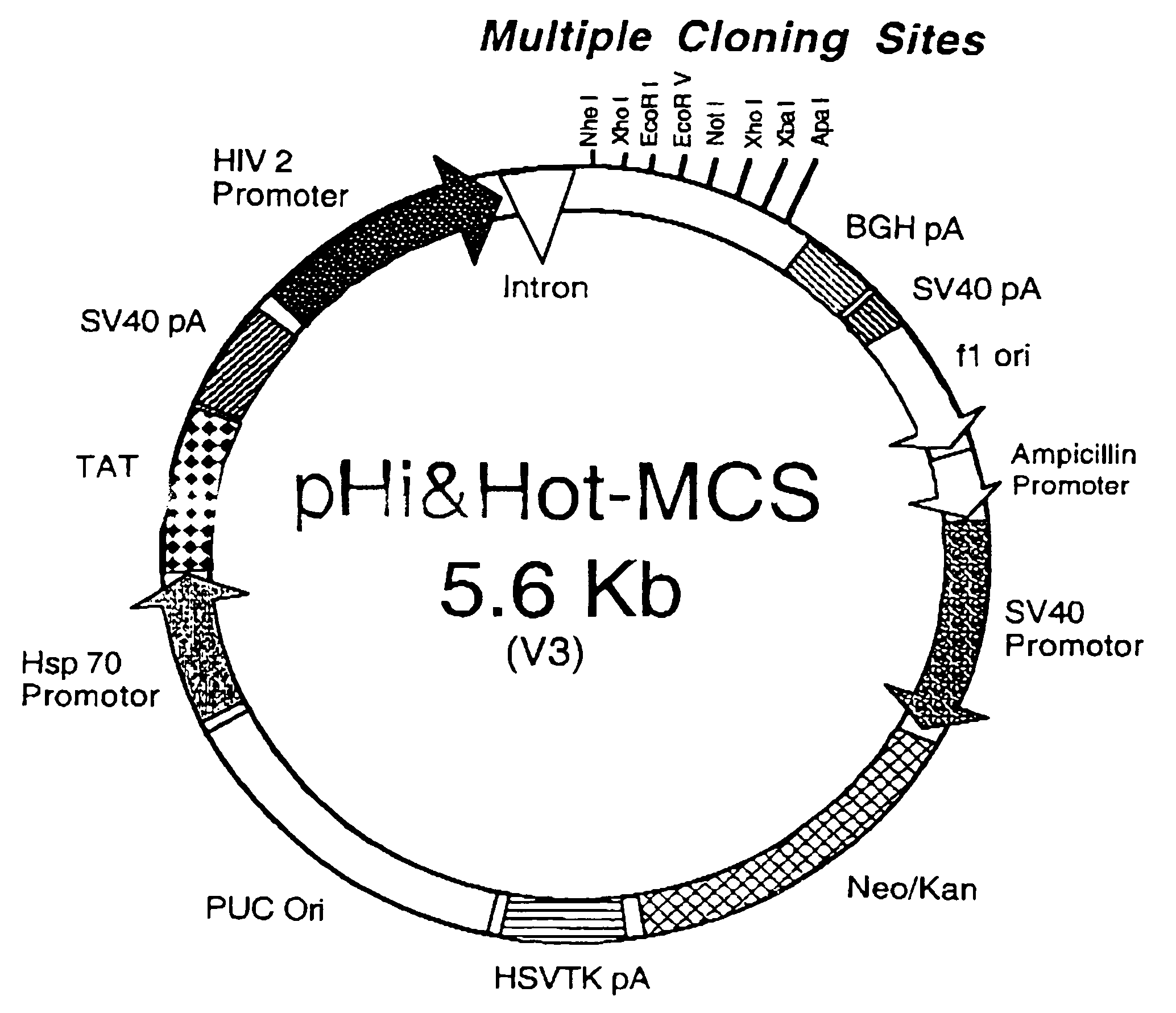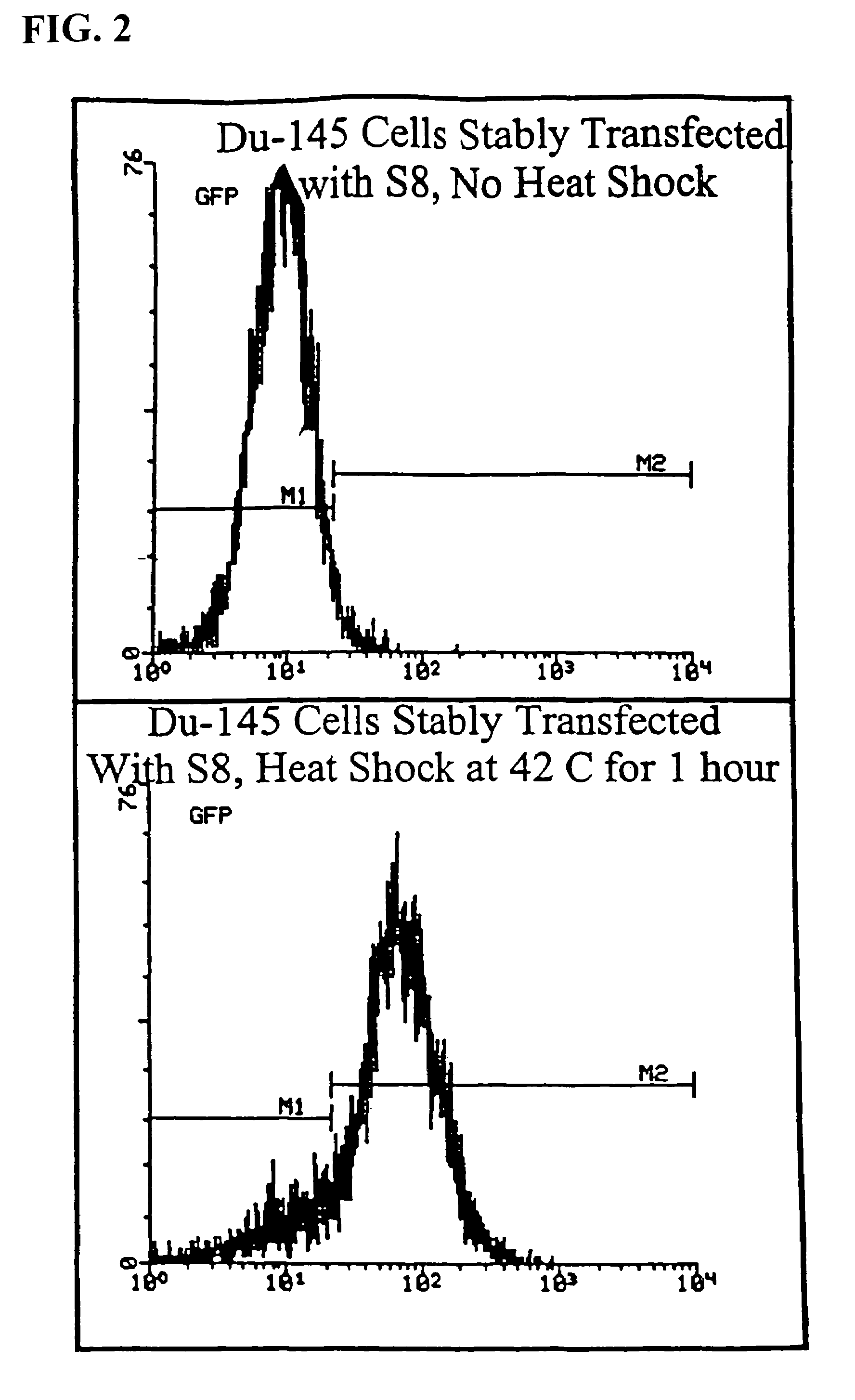Inducible expression vectors and methods of use thereof
a technology of expression vectors and inducible genes, applied in the field of inducible gene expression constructs, can solve the problems of large tumors that cannot be adequately heated by the hyperthermia system, and the depth of tumors
- Summary
- Abstract
- Description
- Claims
- Application Information
AI Technical Summary
Benefits of technology
Problems solved by technology
Method used
Image
Examples
example 1
[0186]The Heat Shock Promoter Can Induce Expression of a Reporter Gene
[0187]Vector Constructs. To study the ability of the HSP70 promoter to induce gene expression, either a minimal heat shock (HS) promoter or a minimal CMV promoter was inserted upstream of a reporter gene in a plasmid containing neomycin and ampicillin selectable markers. The basic design of a plasmid (M5) containing one multiple cloning site in operable position to a promoter derived from HSP70 is shown in FIG. 1. M5 was constructed by replacing the CMV promoter in pcDNA3.0 (Invitrogen, Inc.) with a minimal HSP70B promoter (SEQ ID NO: 1, FIG. 10), a 0.4 kb fragment (HindIII-BamHI) of the human heat shock protein 70B (HSP70B) promoter, obtained from StressGen, Inc.
[0188]Activity of the minimal HS and CMV promoters were determined by transfecting human cancer cells, MCF7 human breast carcinoma cells and DU 145 human prostate carcinoma cells, with the plasmid S8. The S8 plasmid, derived from the M5 vector of FIG. 1, ...
example 2
Expression of IL-2 can be Amplified by the Use of a HIV Promoter and Tat in a Construct
[0211]Initial Amplifier Studies. Studies involving new constructs capable of amplifying a therapeutic gene's expression were performed. To demonstrate the principle of the amplifier idea, several constructs were produced. The constructs contain a constitutive promoter, the CMV promoter, rather than a heat shock induible promoter. These constructs are the plasmids L-27, X14, RR13, Y15, and SS 10. Table 3, below, shows the promoters / genes present in each plasmid and the amount of IL-2 produced. Four of the plasmids were obtained from a plasmid containing two multiple cloning sites. In these four plasmids, the CMV promoter was inserted upstream of either the tat gene or a multiple cloning site (MCS) and either the HIV I or HIV2 long terminal repeats (LTRs) was inserted upstream of the mouse interleukin-2 (IL-2) gene. The plasmids X14 and Y15 are shown schematically in FIGS. 9A and 9B. The L-27 plasmi...
example 3
Heat Inducible Amplifiers
[0214]Vector Construction. To determine if a second promoter could be used to increase the activity of the minimal. HS promoter, MCF-7 cells were transiently transfected with a series of vectors, including pC8, pf12, and p007 (FIGS. 8 and 9). Using a plasmid containing two multiple cloning sites, the minimal heat shock promoter was inserted upstream of either the tat gene or a multiple cloning site (MCS) and either the HIV 1 or HIV2 long terminal repeats (LTRs) was inserted upstream of the mouse interleukin-2 (IL-2) gene. The plasmids also each carried neomycin and ampicillin selectable markers.
[0215]The plasmid f11 was first created by inserting a 0.5 kb EcoRI fragment, containing the interleukin-2 (IL-2) coding region (see GenBank accession no. 577834), from plasmid C5 into the ECOR1 site of the vector M5 (see specific example, Example 1, above). The plasmid C8 was constructed by inserting a 1 kb BamHI fragment, containing the 0.4 kb HSP70B fragment upstre...
PUM
| Property | Measurement | Unit |
|---|---|---|
| temperature | aaaaa | aaaaa |
| temperature | aaaaa | aaaaa |
| temperatures | aaaaa | aaaaa |
Abstract
Description
Claims
Application Information
 Login to View More
Login to View More - R&D
- Intellectual Property
- Life Sciences
- Materials
- Tech Scout
- Unparalleled Data Quality
- Higher Quality Content
- 60% Fewer Hallucinations
Browse by: Latest US Patents, China's latest patents, Technical Efficacy Thesaurus, Application Domain, Technology Topic, Popular Technical Reports.
© 2025 PatSnap. All rights reserved.Legal|Privacy policy|Modern Slavery Act Transparency Statement|Sitemap|About US| Contact US: help@patsnap.com



